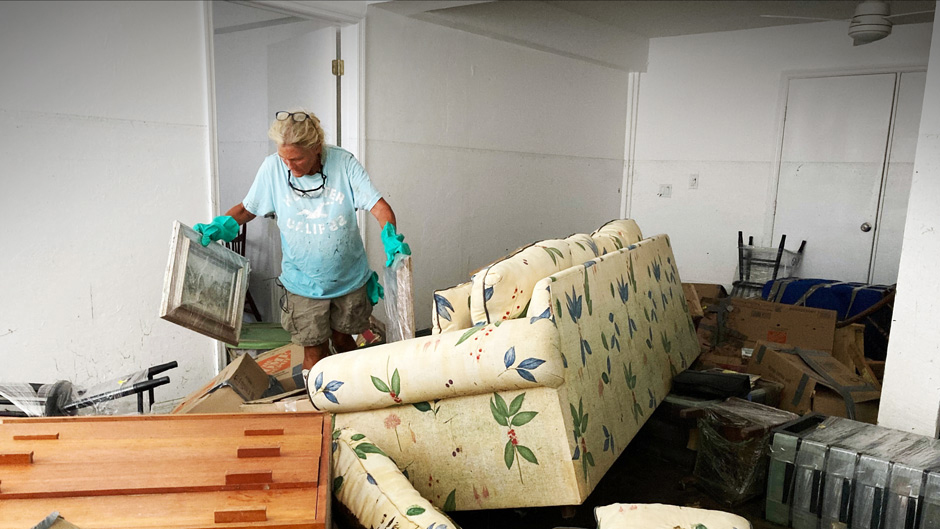Laney Bloch could detect the musty odor the moment she walked into the 57-year-old man’s Fort Myers, Florida, home.
From the outside, the one-story residence looked normal; its roof and windows had withstood Hurricane Ian’s 150-mile-per-hour winds. But floodwaters spawned by the massive cyclone’s storm surge and torrential rains had entered through unsealed windows and doors, turning the inside of the house into a three-foot-deep pool.
While those floodwaters had already receded by the time Bloch, a University of Miami senior, visited the home nearly three months after Ian battered area, they left behind excessive moisture that created the ideal breeding ground for dangerous mold.
“The water line from the flooding was still there weeks after the storm hit, and I could smell the mold,” Bloch said.
She is part of a team of public health science students who recently tested for the presence of mold and other pollutants in Southwest Florida homes damaged by Ian.
“Ian may be just a memory now, but for many people living on the state’s southwest coast, it left behind a growing threat in the form of mold and other bacteria that can have serious and even deadly health consequences,” said Naresh Kumar, a professor of public health sciences at the University of Miami Miller School of Medicine, who trained and traveled with three of his students to different cities along Florida’s Gulf Coast.
Equipped with special sensors, the students took readings in dozens of homes and other buildings in Collier, Lee, Manatee, Pinellas, and Sarasota counties, finding elevated levels of mold in more than half the structures they sampled, according to Kumar.
Students also questioned residents about how long they were without electricity after the storm, whether they had access to food and clean drinking water immediately after the cyclone hit, and if they had any existing health conditions or developed any allergies or other medical complications because of the hurricane.
None of the residents, who were allowed to remain anonymous, reported any serious medical complications. But Kumar intends to review public records to see if there has been any increase in area hospital visits for conditions such as asthma, allergic rhinitis, and chronic bronchitis, because a spike in these types of cases could potentially be linked to exposure to mold caused by the hurricane.
“Following a hurricane, especially one with catastrophic storm surge and serious flooding, an increase in bioaerosols like mold usually occurs in most water-damaged buildings,” Kumar said. “Breathing in mold spores can exacerbate certain conditions and even cause some people to develop an acute response that triggers an allergic reaction and sensitizes them to mold for the rest of their lives.”
Kumar is still analyzing data from his team’s recent trip to Southwest Florida and plans to publish their results. He and the students hope to visit the region again in the spring to follow up with those residents affected by the storm.
“Most of the houses from which we took samples had extensive water damage, and we could easily smell mold after taking just one step into those homes,” said Anton Stremousov, who, along with fellow graduate student Marina Santos Morais took readings at nine residences, including one where mold was visible on the drywall. “Some of those homes are now unfit to live in because of the mold situation,” Morais said.
Mold is not easy to get rid of, especially if a structure’s flooring and walls have been in contact with water for an extended period, according to Kumar. “The floodwaters may recede, but the moisture behind the walls and underneath the floor remains. And with no power or working air-conditioning system after a hurricane, coupled with the fact that Florida is already hot and humid, that’s just the perfect recipe for mold to grow and spread out of control,” he said.
The 57-year-old man whose home Bloch visited now lives in a rental property with his father, who suffers from dementia. “He doesn’t know whether he’ll ever be able to move back into his house,” said Bloch, whose own home in Lee County’s city of Cape Coral suffered damage from Ian. “We were lucky—no major structural damage,” she said.
“Homes can be replaced. People can’t,” said Kumar. He noted news reports of an asthmatic 26-year-old man, Christian Childers, who died not long after being exposed to mold that grew inside his Englewood, Florida, home, which had been damaged by Hurricane Ian’s floodwaters.
“Suffering from the health effects of mold exposure is just one of the stressors that result after hurricanes,” Kumar said. “The power could be off for weeks. There’s not knowing whether you’ll be reimbursed by your insurance company for damages to your home; there’s the loss of employment due to businesses being impacted by the storm. And many of these things can persist for weeks. A lot goes into preparing for hurricanes, but more education and resources need to be dedicated to dealing with their aftereffects.”

